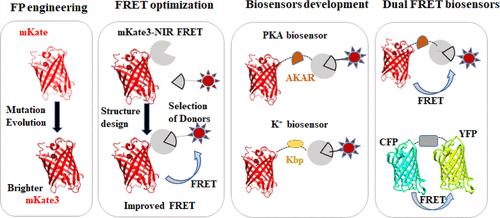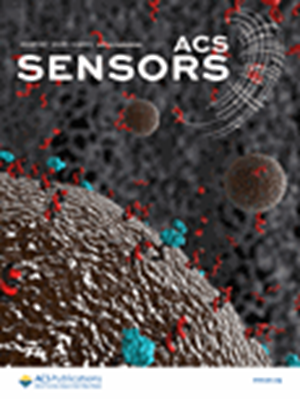Development of mKate3/HaloTag7 (JFX650) and CFP/YFP Dual-Fluorescence (or Förster) Resonance Energy Transfer Pairs for Visualizing Dual-Molecular Activity
IF 8.2
1区 化学
Q1 CHEMISTRY, ANALYTICAL
引用次数: 0
Abstract
Although several imaging strategies for dual fluorescence (or Förster) resonance energy transfer (FRET) biosensors have been reported, their implementation is challenging because of the limited performance of fluorescent proteins and the spectral overlap of FRET biosensors. These processes often require additional data calibration to eliminate artifacts. Many CFP/YFP FRET biosensors have been developed. In this study, we introduced the mKate3/HT7(JFX650) FRET pair, which effectively formed two pairs of FRET pairs for dual-FRET imaging when combined with the CFP/YFP FRET pair. The FRET donor mKate3 exhibited higher brightness than its predecessor mKate. The FRET acceptor, HT7(JFX650), is a HaloTag7 protein covalently conjugated with a far-red JFX650-THL ligand. The pair comprising mKate3 and HT7(JFX650) represents an excellent FRET dyad, exhibiting a high FRET efficiency ratio. To use the FRET pair for dual FRET biosensor imaging, we constructed PKA and K+ biosensors based on the mKate3/HT7(JFX650) FRET pair. These biosensors can be used along with CFP/YFP biosensors to simultaneously detect the responses of intracellular PKA/Src, PKA/Ca2+, and K+/Ca2+ under different stimuli. The findings revealed that dual FRET biosensors, which are based on the combination of CFP/YFP and mKate3/HT7 (JFX650), exhibit adequate compatibility and can be used to visualize multiple molecular activities in a live cell.

开发用于观察双分子活性的 mKate3/HaloTag7 (JFX650) 和 CFP/YFP 双荧光(或佛斯特)共振能量转移对
尽管已经报道了几种双荧光(或福斯特)共振能量转移(FRET)生物传感器的成像策略,但由于荧光蛋白的性能有限以及 FRET 生物传感器的光谱重叠,这些策略的实施具有挑战性。这些过程通常需要额外的数据校准来消除伪影。目前已开发出许多 CFP/YFP FRET 生物传感器。在本研究中,我们引入了 mKate3/HT7(JFX650) FRET 对,当与 CFP/YFP FRET 对结合时,可有效形成两对 FRET 对,用于双 FRET 成像。与前代 mKate 相比,FRET 供体 mKate3 的亮度更高。FRET 受体 HT7(JFX650) 是与远红 JFX650-THL 配体共价结合的 HaloTag7 蛋白。mKate3 和 HT7(JFX650)组成的配对是极好的 FRET 对,具有很高的 FRET 效率比。为了将这对 FRET 对用于双 FRET 生物传感器成像,我们构建了基于 mKate3/HT7(JFX650) FRET 对的 PKA 和 K+ 生物传感器。这些生物传感器可与 CFP/YFP 生物传感器一起用于同时检测不同刺激下细胞内 PKA/Src、PKA/Ca2+ 和 K+/Ca2+ 的反应。研究结果表明,基于 CFP/YFP 和 mKate3/HT7 (JFX650) 组合的双 FRET 生物传感器具有足够的兼容性,可用于观察活细胞中的多种分子活动。
本文章由计算机程序翻译,如有差异,请以英文原文为准。
求助全文
约1分钟内获得全文
求助全文
来源期刊

ACS Sensors
Chemical Engineering-Bioengineering
CiteScore
14.50
自引率
3.40%
发文量
372
期刊介绍:
ACS Sensors is a peer-reviewed research journal that focuses on the dissemination of new and original knowledge in the field of sensor science, particularly those that selectively sense chemical or biological species or processes. The journal covers a broad range of topics, including but not limited to biosensors, chemical sensors, gas sensors, intracellular sensors, single molecule sensors, cell chips, and microfluidic devices. It aims to publish articles that address conceptual advances in sensing technology applicable to various types of analytes or application papers that report on the use of existing sensing concepts in new ways or for new analytes.
 求助内容:
求助内容: 应助结果提醒方式:
应助结果提醒方式:


